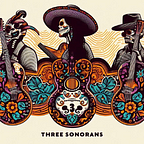The Birth of Huitzilopochtli, and the Winter Solstice
The following story was taken from the Curanderismo, the Healing Art of Mexico Facebook page.
“The allegorical story is told that when the moon, Coyolxauhqui, along with her brothers Tzentzowitznawac found out that their mother Coatlicue (Mother Earth) had become pregnant after tucking an eagle feather into her breast, they became angry and plotted to kill her.
However, their brother Huitzilopochtli (the sun) while still in his mother’s womb, heard their plan and assured his mother that he would help her and in so doing was born fully formed. Upon his birth (the rising sun), he drove his siblings away (the stars of the night sky) and dismembered his sister the moon (representing the moon in her four aspects: new, waxing, full, and waning).
During the days preceding the solstice, the sun travels across the sky producing the effect that appears to us as if it is leaning towards the south and left, much like the human heart (Abajo y a La Izquierda). At this point, the sun has already traveled the sky for many days and “dies” on December 20 (the shortest day and so less sunlight). The sun goes to Mictlan, the place of the dead, to battle the darkness (longest night) and is reborn victorious on the 21st as Hummingbird, demonstrating great heart and willpower. The old ones, who were great astronomers and mathematicians, noted this celestial phenomenon as the birth of Huitzilopochtli, of the Sun, with great celebrations of music, dance, and food. Elders encouraged people to hold only good thoughts and to generously offer friends and neighbors food and drink. Gifts of baked blue corn mixed with black honey in the shape of Huitzilopochtli were also offered to friends and at temples.
At this point, the sun has already traveled the sky for many days and “dies” on December 20 (the shortest day and so less sunlight). The sun goes to Mictlan, the place of the dead, to battle the darkness (longest night) and is reborn victorious on the 21st as Hummingbird, demonstrating great heart and willpower. The old ones, who were great astronomers and mathematicians, noted this celestial phenomenon as the birth of Huitzilopochtli, of the Sun, with great celebrations of music, dance, and food. Elders encouraged people to hold only good thoughts and to generously offer friends and neighbors food and drink. Gifts of baked blue corn mixed with black honey in the shape of Huitzilopochtli were also offered to friends and at temples.
The old ones, who were great astronomers and mathematicians, noted this celestial phenomenon as the birth of Huitzilopochtli, of the Sun, with great celebrations of music, dance, and food. Elders encouraged people to hold only good thoughts and to generously offer friends and neighbors food and drink. Gifts of baked blue corn mixed with black honey in the shape of Huitzilopochtli were also offered to friends and at temples.
Taking a deeper view, the word Huitzilopochtli is made up of two other words: huitzilin, hummingbird, and opochtli, left (side), and is a metaphor for our heartbeat; for heart-centered will power and volition — consider the immense energy and determination of the hummingbird that flies thousands of miles from the South to the North and back again.
The birth of Huitzilopochtli represents light overcoming darkness (consciousness and unconsciousness), self-mastery (overcoming the challenges of the Sun’s long night of the soul), and willpower. It is the challenging inner work known as the Flowery War; our internal battle to awaken from the dream of materialism and of living without purpose.
Mexika, pre-contact and many still today, like many peoples around the world, observe the Solstice with special rituals, prayers, and ceremonies that represent the work of mastering our inclination towards unconscious living, accomplishing the awakening of our higher awareness — Quetzalcoatl consciousness — and deepening our connection to the cosmic forces of the universe and the Great Mystery.”
— Grace Alvarez Sesma, Curanderismo, the Healing Art of Mexico
Hold only good thoughts.
For All Our Relations.
Artwork: Huitzilopochtli by David Gremard Romero of El Tonalamatl Ollin FB page. Look carefully for all the beautiful symbols/glyphs (the dismembered moon is on the lower left side beneath his arm; the main aspect of Huitzilopochtli is above mother earth) contained in the painting. http://www.gremardromero.com/
Some of the information for this post is from: http://www.travelbymexico.com/blog/5295-la-navidad-celebrada-por-los-aztecas/ and the FB page of Tlacaelel. Tlazocahmati huel miac.
Originally published at TSON News.
